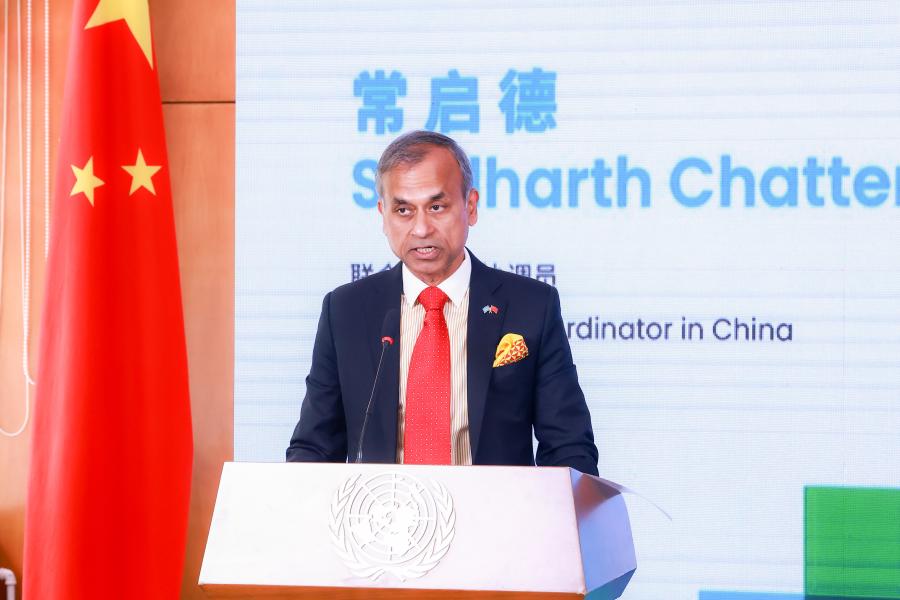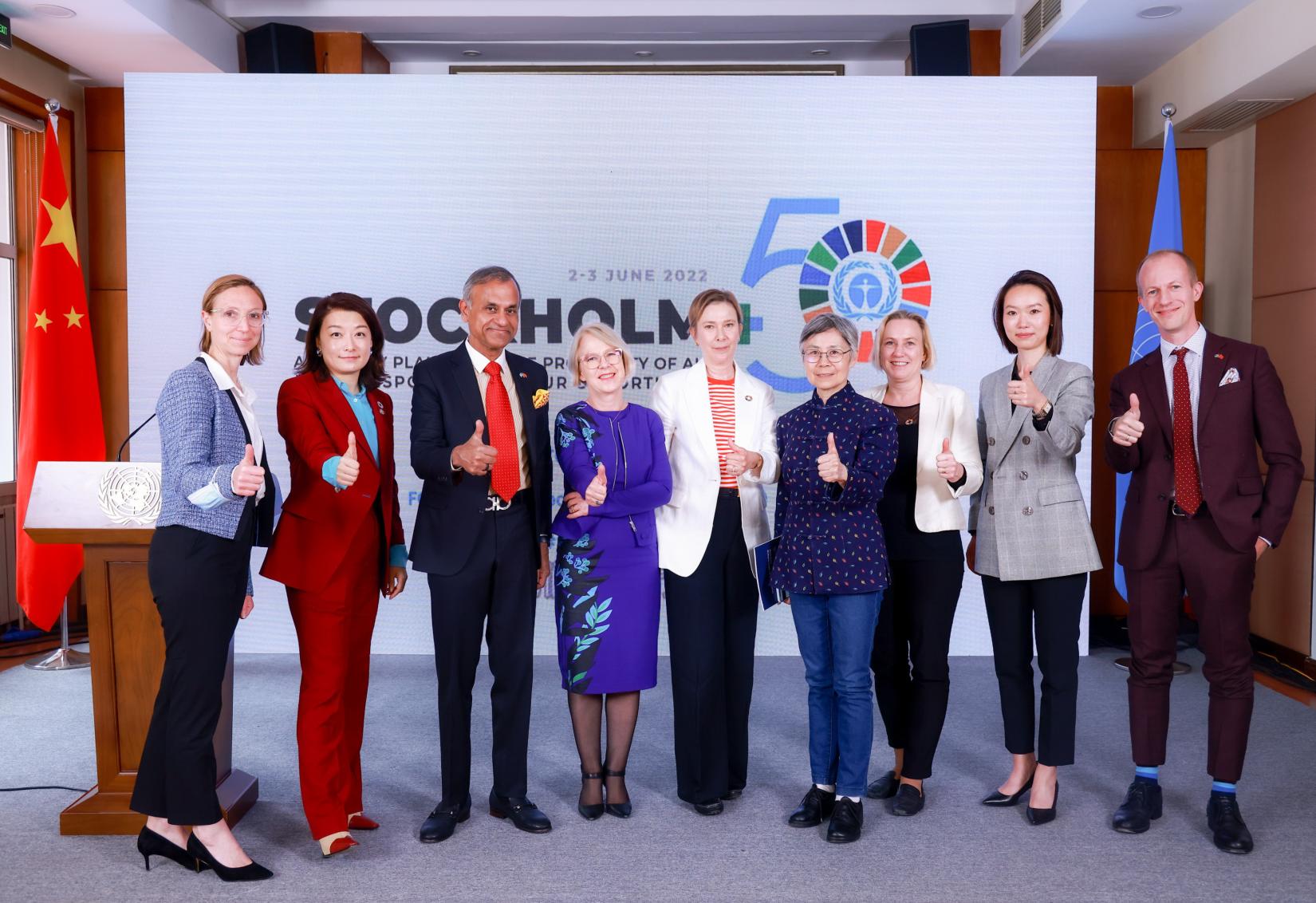High-Level Reception of Stockholm+50: A healthy planet for the prosperity of all - our responsibility, our opportunity
Remarks by Siddharth Chatterjee, UN Resident Coordinator in China
(Check against delivery)
Madam Ambassador Sångeland,
Excellencies and colleagues,
Ladies and Gentlemen,
Good afternoon.
Let me thank colleagues from the Embassy of Sweden for spearheading today’s event, as well as the United Nations Development Programme (UNDP) and United Nations Environment Programme (UNEP) teams for their diligent work in organizing the stakeholder consultation for Stockholm +50, in commemoration of the 1972 Stockholm Declaration.

50 years ago, the crew of Apollo 17 shot the only human-captured, full-face, colour picture of the illuminated earth, a photo that became famous as "The Blue Marble", a now-iconic symbol of our common home set against the wide, black expanse of outer space.[1]
50 years ago, on 5 June 1972, we also saw countries around the world rally together in Stockholm for the first UN Conference on the Human Environment.
After 12 days, they issued the Stockholm Declaration, marking a turning point in the development of international environmental governance, leading to the establishment of UNEP and designating June 5 as World Environment Day.[2]
The Stockholm Declaration is a strong message that has become part of our shared understanding: the entire world, developed and developing countries alike, faces serious environmental challenges that can only be addressed by collective action.
50 years on, we have seen what can be achieved when the world comes together.
We have achieved success in reversing the depletion of the Ozone Layer, and sustainable development is no longer an abstract concept, but a blueprint shared by all 193 UN Member States, enshrined in the 2030 Agenda for Sustainable Development and the 17 Sustainable Development Goals.
However, we also witness the countless man-made environmental degradations that damage our planet and worsen day by day, through biodiversity loss, air and chemical pollution, deforestation, plastic waste, and much more.
We also face the existential crisis brought forward by climate change.
In 2020 alone, 31 million people have been displaced due to climate-related disasters[3], and more alarmingly, the 6th Assessment Report of the Intergovernmental Panel on Climate Change warns us that nearly half of humanity stands in the danger zone.[4]
As the UN Secretary-General António Guterres has said, the world is “sleepwalking to climate catastrophe”[5].
We must wake up and act now.

The science is clear, we need to reduce global CO2 emissions by 45% by 2030 to keep the goal of limiting the rise in global temperature to 1.5-degrees alive.[6]
To address the emission gap for a successful green transition, that is also just and inclusive, there is a need for stronger political signals, higher funding, and effective technological support and transfers.
- Firstly, developed countries need to hold to the promise to provide 100 billion USD annually for climate adaptation and mitigation efforts. 7 years later, we are still short of this target. According to the latest UNEP Adaptation Gap Report, current adaptation financing is still 5 to 10 times less than needed annually.[7]
- Secondly, affordable clean technology transfers are also essential to accelerate the transition of developing economies' to green and sustainable economies. Cutting-edge technologies such as energy storage, big data, and artificial intelligence, will be essential to mitigate, measure and offset carbon emissions.
- Thirdly, climate commitments at the global level require concrete and operational plans. It is actions, not words, that are needed to address the climate emergency.
As China’s Special Envoy for Climate Change Xie Zhenhua expressed, there is a real need to strengthen global climate action to achieve a systemic change, and on this, we need China’s full engagement.
As a consequence of its size and population, China is the world's largest emitter of CO2, however, it is also at the frontier in the pivotal technologies for the green transition, such as renewables and energy grid infrastructure.
In this sense, China has great potential to fast-track and accelerate both domestic and international processes for the green transition, while meeting and beating its’ ambition of achieving peak carbon emissions by 2030 and carbon neutrality by 2060.
China has already cut its CO2 emissions intensity by 48.4 per cent per unit of GDP since 2005[8], but much more remains to be done in China, for the difficult balance between priorities such as economic growth, energy security, and the need for green transformation, as in all countries, remains a challenge for China.
The UN Country Team will support China in its efforts to achieve its climate target, as well as fulfil its’ international commitments under the Paris Agreement and the 2030 Agenda.
Under our Cooperation Framework, we stand ready to provide technical expertise and support for China to realize its low-carbon transition and also help share China’s experience, expertise, and resources to accelerate global climate action.
Conferences such as Stockholm +50 are an integral part of the UN’s partnership with China, and as we learnt from Professor Qu Geping, the Stockholm Conference was the first major UN event following China’s return to the Organization in 1971.
Today we are honoured to hear from Swedish as well as Chinese perspectives on environmental protection, with Dr. Lonnroth and Dr. Li Lailai, co-authors with Professor Qu Geping on the book “Ocean Currents Are Still Protecting Us”, who will share their insights.
Just as the title of this book suggests, let's listen to our planet and people, and act for renewed multilateral environmental action and climate change cooperation to protect the lives and livelihoods on this ‘Blue Marble’.
Thank you.
[1] NASA. Available at https://www.nasa.gov/image-feature/the-blue-marble-the-view-from-apollo…
[2] Background of the World Environment Day, United Nations. Available at https://www.un.org/en/observances/environment-day/background
[3] IFRC, Displacement in a Changing Climate. Available at https://www.ifrc.org/sites/default/files/2021-10/IFRC-Displacement-Clim…
[4] IPCC News Release. Available at https://www.ipcc.ch/2022/02/28/pr-wgii-ar6/
[5] Secretary-General's remarks to Economist Sustainability Summit. Available at https://www.un.org/sg/en/content/sg/speeches/2022-03-21/remarks-economi….
[6] Summary for Policy Maker, IPCC. Available at https://www.ipcc.ch/sr15/chapter/spm/
[7] UNEP (2021). Adaptation Gap Report.
[8] The State Council Information Office, “Responding to Climate Change: China's Policies and Actions”, 27 October 2021. Available at http://www.scio.gov.cn/zfbps/32832/Document/1715506/1715506.htm.
Speech by





